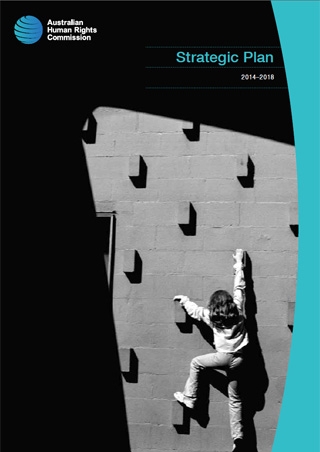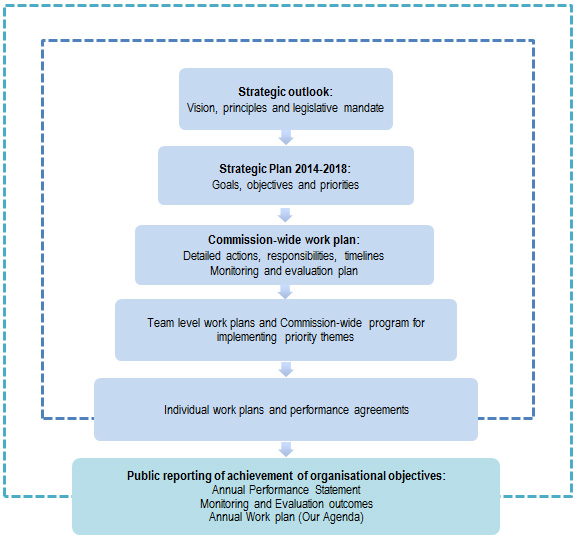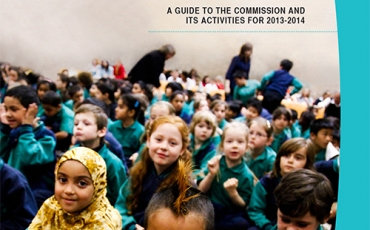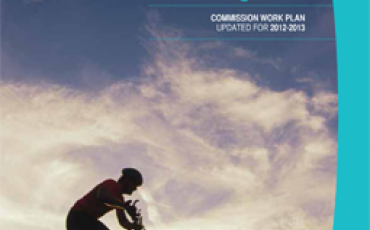Strategic Plan 2014-2018

Foreword
I am pleased to present the Australian Human Rights Commission’s Strategic Plan for 2014-18.
The plan provides a roadmap that guides our key activities over the coming four year period.
As an organisation we seek to be innovative and agile in how we continue to improve our operations and ensure maximum benefit for the Australian community.
The plan meets the Commission’s new legal obligations as an independent corporate entity under the Public Governance, Performance and Accountability Act 2013 (Cth).
The Act requires the Commission to have a four year corporate plan that forms the basis of annual reporting of performance and evaluation. We have built upon our planning framework to ensure we meet the reporting obligations that come from these legislative requirements.
As a Commission, we have decided to focus our work over the next four years on three priority areas:
- Human rights education and promotion – to build awareness of rights and freedoms in the community
- Engaging with business on human rights – to encourage innovation in promoting human rights, to provide support to prevent workplace discrimination and to assist in resolving disputes
- Ensuring freedom from violence, harassment and bullying – by promoting human rights safeguards.
Respect for human rights and freedoms is the cornerstone of a cohesive and peaceful society in which everyone can make a contribution and feel safe and included.
Ultimately, the purpose of this plan is to make clear our strategies to ensure an Australian society where human rights are enjoyed by everyone, everywhere, everyday.
Emeritus Professor Gillian Triggs
President
Australian Human Rights Commission
June 2014
Who we are
The Australian Human Rights Commission is our national human rights institution.
We operate under the Australian Human Rights Commission Act 1986 (Cth) as well as federal laws that seek to ensure freedom from discrimination on the basis of age, disability, race, sex and sexual orientation. The Commission also has specific responsibilities under the Native Title Act 1993 (Cth) and the Fair Work Act 2009 (Cth).
Our operations are determined independently of the government through our President and Commissioners. We operate as a Corporate Commonwealth Entity under the Public Governance, Performance and Accountability Act 2013 (Cth).
Our job is to work towards an Australia in which human rights are respected, protected and promoted – finding practical solutions to issues of concern, advocating for systemic change and raising awareness across the community.
Much of this work is at the policy level – engaging with the public and the media; and encouraging government, industry and community groups alike to see fundamental rights and freedoms realised. It involves building the case for change on issues ranging from paid parental leave to age discrimination in employment. It involves providing a human rights analysis to the courts and to parliamentary inquiries, conducting research and contributing to partnerships.
Our work also involves exchanging ideas with equivalent bodies around the world, while closer to home, we monitor and report on the experiences of those particularly vulnerable to disadvantage.
From addressing individual complaints of discrimination, to engaging with government on policy issues, the Commission’s task is both to apply those rights that are currently recognised in our laws; and to aspire for greater recognition and protection of those that are not.
Our vision is for an Australia where human rights are enjoyed by everyone, everywhere, everyday.
Our vision, mission and principles
In delivering our work we are guided by the common purpose and values held within our vision, mission and principles statement.
Vision
Human rights: everyone, everywhere, everyday
Mission
To lead the promotion and protection of human rights and freedoms in Australia by:
- Making human rights part of everyday life and language
- Empowering all people to understand and exercise their rights and responsibilities
- Providing a timely and impartial national investigation and dispute resolution service
- Holding government accountable to international human rights obligations and domestic legal standards
- Fostering collaborations that inspire action on human rights.
Principles
The Commission seeks to apply a human rights based approach to its own work. This involves respect for five principles:
- Participation – everyone has the right to participate in decisions which affect them
- Accountability – effective monitoring of compliance with human rights standards, as well as effective remedies for human rights breaches
- Non-discrimination and equality – people are treated without discrimination and in pursuit of equality before the law
- Empowerment – all members of the community understand their rights and responsibilities, and this contributes to their ability to make choices about how they participate in the community
- Legality – the law recognises, and is consistent with, rights and freedoms.
Strategic goals
There is no simple way to solve complex human rights issues. From the challenges that face a person with a disability seeking to live independently, to ensuring that Australia’s immigration detention policies meet our human rights obligations and treat people with dignity, the promotion of human rights must address issues for individuals as well as the need for broader, systemic change.
This Strategic Plan is the road map that guides the Commission’s work for the four year period. The dashboard over the page outlines our goals, objectives and priorities.
The goals reflect our aspirations as an organisation. They are ambitious and require sustained action over time.
The objectives provide a framework that enables us to plan our work and to monitor progress in our mandate to achieve improved respect and protection of human rights in Australia.
The three priorities provide a thematic focus that cuts across all areas of our work – from the advocacy of our commissioners, to our policy and research program, to the work of our Investigation and Conciliation Service.
Strategic Goals 2014-2018
| Goal 1: Leadership |
Goal 2: Rights and freedoms are protected |
Goal 3: Access to effective information and dispute resolution services |
Goal 4: Organisational excellence |
|---|---|---|---|
|
We are respected for our independent and influential promotion of the full implementation of human rights and freedoms in Australia and internationally. Human rights issues are on the national agenda and are part of public debate, resulting in:
As Australia’s national human rights institution, we are known for undertaking our role impartially and for our expertise and evidence-based research. We emphasise how human rights apply to everyday life, with a particular emphasis on those who are marginalised in our society. |
We are a collaborative, innovative and flexible workplace that fosters excellence and expertise in our staff and in our work. We lead by example, and are transparent and accountable in how we operate, including by:
Our Commissioners work in a collegiate manner that reflects the universality and indivisibility of human rights. |
We provide timely and impartial services to address questions and disputes about human rights and discrimination. We assist individuals, businesses, organisations and governments to understand rights and responsibilities and take action to prevent and resolve disputes about human rights and discrimination. This is achieved through:
|
We are a collaborative, innovative and flexible workplace that fosters excellence and expertise in our staff and in our work. We lead by example, and are transparent and accountable in how we operate, including by:
Our Commissioners work in a collegiate manner that reflects the universality and indivisibility of human rights. |
| Goal 1: Objectives | Goal 2: Objectives | Goal 3: Objectives | Goal 4: Objectives |
|---|---|---|---|
|
1.1 Effective reach in the general community and among identified target audiences with relevant and useful information about human rights, including discrimination. 1.2 Public awareness and debate about human rights issues increases through our communications and public presence. 1.3 Constructive relationships are developed and maintained with parliament, government, community, business and other stakeholders. 1.4 Increased capacity to apply human rights through our education and technical cooperation activities. 1.5 Impact through our contributions to United Nations processes in our capacity as a national human rights institution.
|
2.1 Our research, advocacy and recommendations are cited or acted upon by parliament, governments, the courts, businesses and in the community. 2.2 Effective education, training and information resources increase human rights knowledge and skills and contribute to changes in attitudes and behaviours. 2.3 The human rights impact of violence, harassment and bullying is increasingly understood and contributes to preventive measures being taken that improve safety. 2.4 Effective support for business contributes to more inclusive and productive workplaces, and provides redress for workplace discrimination. 2.5 Increased capacity to take action by those vulnerable to, experiencing or witnessing human rights breaches and other discrimination. |
3.1 Our National Information Service is recognised as a leading source of information about federal human rights and discrimination law and the associated complaint process. 3.2 Disputes relating to breaches of human rights and discrimination are effectively and efficiently resolved. 3.3 Participation in the investigation and conciliation process results in increased understanding of rights and responsibilities in the law. 3.4 The terms on which disputes are resolved include systemic outcomes that accord with the objectives of the law. |
4.1 Effective governance is maintained by our Executive and provides strategic leadership for the organisation. 4.2 Corporate services are provided to internal and external clients efficiently and flexibly, while meeting professional standards and legislative requirements and providing effective financial controls. 4.3 Staff feel engaged and valued with a work life balance, professional development and job satisfaction. 4.4 A diverse and safe workplace is maintained with high performing staff. 4.5 Effective systems to monitor and evaluate our work are implemented and are used to improve the quality and impact of our work. 4.6 Internal processes effectively promote communication and coordination and enhance the quality of our work. |
| Priorities: | Human rights education and promotion: We build awareness of rights and freedoms across the community and encourage a culture of respect and responsibility that values dignity. | Engaging with business on human rights: We encourage innovation in how business respects, protects and promotes human rights, and provide comprehensive and effective support to prevent workplace discrimination and assist in the resolution of disputes. | Freedom from violence, harassment and bullying: We promote safety by ensuring that human rights protections are in place, by encouraging bystander action and by resolving related disputes. |
|---|
Integrating our strategic goalsinto our day to day work
The diagram below illustrates how our annual planning processes, as well as our monitoring and evaluation activities, are aligned with this Strategic Plan. This enables us to review and report each year on our progress in meeting our organisational objectives and over time, to assess what impact we are making through these in achieving our mandate and goals.
Integrating the strategic goals into our activities
Each year we develop a Commission-wide work plan to guide our day to day work. This outlines the projects and activities that we are undertaking to achieve our organisational objectives. This in turn informs how we allocate our limited resources.
This is the first Strategic Plan developed by the Commission since the Public Governance Performance and Accountability Act 2013 (Cth) (PGPA Act) came into force. The PGPA Act requires the Commission to meet a series of new performance requirements for Commonwealth agencies through the preparation of an Annual Performance Statement in our Annual Report and publicly reported monitoring and evaluation initiatives. These reporting requirements are also reflected in the above diagram.
We conduct our activities within a learning and improvement framework, so we can know what we are contributing towards improved protection of human rights in Australia. We implement a monitoring and evaluation framework that is aligned with and appropriative to our strategic plan. It helps us to answer the questions: How much did we do? How well did we do it? and What difference did we make?
Our evaluation framework not only provides this accountability but it also assists us to:
- assess implementation methods and process
- guide program development
- assist decision making
- add to existing knowledge and promote best practice
- identify gaps in knowledge and research
- meet our annual reporting obligations to government under the PGPA Act.
We acknowledge that assessing the impact of our work is a complex task, as our efforts are often linked to longer term goals, multiple activities, collaborative approaches and result in incremental change. This means it is not always possible to directly attribute outcomes solely or predominately to our efforts.
The Commission aims to achieve a ‘line of sight’ between individual staff work plans and the distinct activities conducted by their work areas up to the goals and objectives contained in this Strategic Plan.
The strategic plan is intended to be a dynamic, living document that changes to reflect what we learn and achieve over time and to adapt to our changing internal and external environment.
Integration matrix
The integration matrix below identifies the main systems that we have put in to place to track how we achieve our strategic goals over the next four years.
| Action | Outcome | Responsibility |
|---|---|---|
| A Commission-wide work plan is developed annually to guide our work activities. |
A work plan for the entire Commission is approved by the Commission Executive at the beginning of each financial year. It identifies key priorities, milestones and peak workload periods across the Commission for the year. All projects and activities are linked to the goals, priorities and objectives in this Strategic Plan. |
All staff, led by team managers and coordinated by the Director – Policy & Programs. |
| Team work plans are designed to advance our strategic goals, priorities and objectives. |
Team activities are agreed by the Commission on an annual basis following a planning and peer review process that identifies the best projects to advance the key objectives of our Strategic Plan. Each team draws on their evaluation and evidence to identify how the activities for the coming year can deliver the main outcomes identified in the strategic plan. |
All staff, led by team managers. |
| Performance management scheme integrates the strategic plan. |
All staff have a performance agreement that indicates their role in conducting activities and projects. These projects and activities have a ‘line of sight’ to the strategic goals, priorities and objectives. |
Commission managers. All staff are responsible for meeting performance measures. |
| Monitoring and evaluation framework ensures project evaluations are congruent with the strategic plan and meet our PGPA reporting requirements. |
All projects and activities incorporate a monitoring and evaluation component designed to assess impact against our strategic objectives, priorities and goals. We document our progress towards achieving our strategic objectives and goals. |
Executive Director; Director – Policy & Programs; Director – Investigation and Conciliation Service; and team Managers. All staff are responsible for conducting relevant monitoring and evaluation activities. |
| Annual report and web-based tools report on progress in achieving strategic goals and outcomes of evaluations. | Our Annual Report includes an Annual Performance Statement on progress in achieving our strategic goals, as well as an Evaluation Outcomes Report. We publish our annual workplan online, as well as other materials required to meet our performance and reporting obligations the PGPA Act. | Executive Director; Director – Policy & Programs; and Director – Investigation and Conciliation Service to coordinate with team managers. |
| Learning and development framework supports capacity of staff to implement the strategic plan. |
Learning and development framework identifies staff capacity needed to achieve strategic goals. Framework includes opportunities to learn from internal and external expertise. Staff participate in training and feedback reflects strong professional and personal value. |
Human Resources coordinate in consultation with Director – Policy & Programs; Director – Investigation and Conciliation Service; and team managers. All staff to participate in delivery of and attendance in learning opportunities. |
Vision: Human rights: everyone, everywhere, everyday
| Mission | Principles | ||
|---|---|---|---|
|
Goal 1: We are respected for our independent and influential promotion of the full implementation of human rights and freedoms in Australia and internationally. |
Goal 2: Human rights and freedoms are respected in Australian law, policy and practice, and are understood by the Australian community. |
Goal 3: We provide timely and impartial services to address questions and disputes about human rights and discrimination. |
Goal 4: We are a collaborative, innovative and flexible workplace that fosters excellence and expertise in our staff and in our work. |
| ↑ | ↑ | ↑ | ↑ |
| Priorities: Human rights education and promotion – Engaging with business on human rights –Freedom from violence, harassment and bullying |
|||
| ↑ | ↑ | ↑ | ↑ |
| Objectives | |||
| ↑ | |||
| Annual work plan | |||




